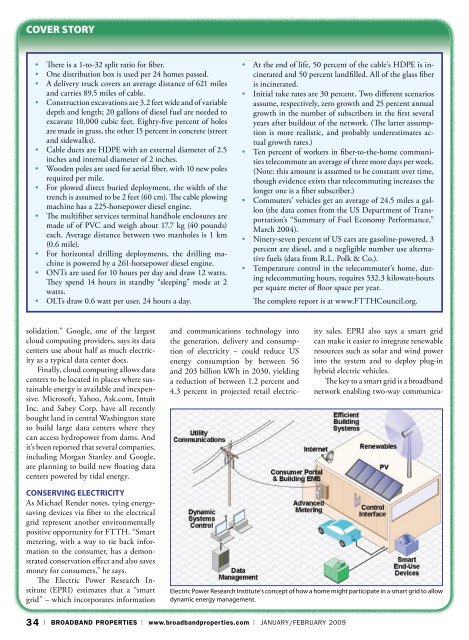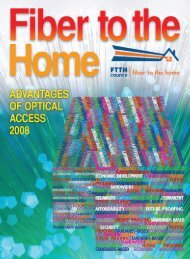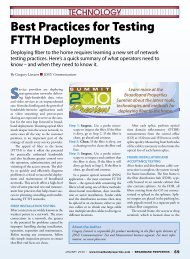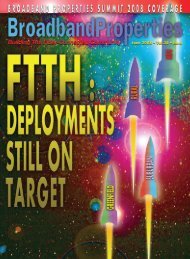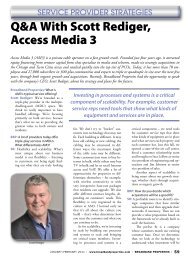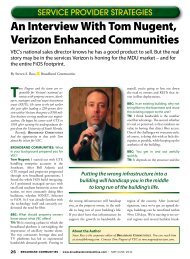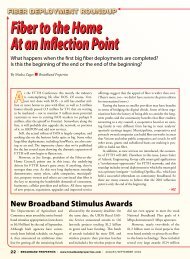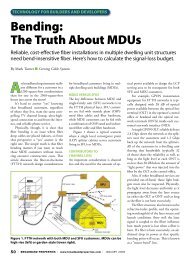bbpmag.com - Broadband Properties
bbpmag.com - Broadband Properties
bbpmag.com - Broadband Properties
You also want an ePaper? Increase the reach of your titles
YUMPU automatically turns print PDFs into web optimized ePapers that Google loves.
Cover Story<br />
• There is a 1-to-32 split ratio for fiber.<br />
• One distribution box is used per 24 homes passed.<br />
• A delivery truck covers an average distance of 621 miles<br />
and carries 89.5 miles of cable.<br />
• Construction excavations are 3.2 feet wide and of variable<br />
depth and length; 20 gallons of diesel fuel are needed to<br />
excavate 10,000 cubic feet. Eighty-five percent of holes<br />
are made in grass, the other 15 percent in concrete (street<br />
and sidewalks).<br />
• Cable ducts are HDPE with an external diameter of 2.5<br />
inches and internal diameter of 2 inches.<br />
• Wooden poles are used for aerial fiber, with 10 new poles<br />
required per mile.<br />
• For plowed direct buried deployment, the width of the<br />
trench is assumed to be 2 feet (60 cm). The cable plowing<br />
machine has a 225-horsepower diesel engine.<br />
• The multifiber services terminal handhole enclosures are<br />
made of of PVC and weigh about 17.7 kg (40 pounds)<br />
each. Average distance between two manholes is 1 km<br />
(0.6 mile).<br />
• For horizontal drilling deployments, the drilling machine<br />
is powered by a 261-horsepower diesel engine.<br />
• ONTs are used for 10 hours per day and draw 12 watts.<br />
They spend 14 hours in standby “sleeping” mode at 2<br />
watts.<br />
• OLTs draw 0.6 watt per user, 24 hours a day.<br />
• At the end of life, 50 percent of the cable’s HDPE is incinerated<br />
and 50 percent landfilled. All of the glass fiber<br />
is incinerated.<br />
• Initial take rates are 30 percent. Two different scenarios<br />
assume, respectively, zero growth and 25 percent annual<br />
growth in the number of subscribers in the first several<br />
years after buildout of the network. (The latter assumption<br />
is more realistic, and probably underestimates actual<br />
growth rates.)<br />
• Ten percent of workers in fiber-to-the-home <strong>com</strong>munities<br />
tele<strong>com</strong>mute an average of three more days per week.<br />
(Note: this amount is assumed to be constant over time,<br />
though evidence exists that tele<strong>com</strong>muting increases the<br />
longer one is a fiber subscriber.)<br />
• Commuters’ vehicles get an average of 24.5 miles a gallon<br />
(the data <strong>com</strong>es from the US Department of Transportation’s<br />
“Summary of Fuel Economy Performance,”<br />
March 2004).<br />
• Ninety-seven percent of US cars are gasoline-powered, 3<br />
percent are diesel, and a negligible number use alternative<br />
fuels (data from R.L. Polk & Co.).<br />
• Temperature control in the tele<strong>com</strong>muter’s home, during<br />
tele<strong>com</strong>muting hours, requires 532.3 kilowatt-hours<br />
per square meter of floor space per year.<br />
The <strong>com</strong>plete report is at www.FTTHCouncil.org.<br />
solidation.” Google, one of the largest<br />
cloud <strong>com</strong>puting providers, says its data<br />
centers use about half as much electricity<br />
as a typical data center does.<br />
Finally, cloud <strong>com</strong>puting allows data<br />
centers to be located in places where sustainable<br />
energy is available and inexpensive.<br />
Microsoft, Yahoo, Ask.<strong>com</strong>, Intuit<br />
Inc. and Sabey Corp. have all recently<br />
bought land in central Washington state<br />
to build large data centers where they<br />
can access hydropower from dams. And<br />
it’s been reported that several <strong>com</strong>panies,<br />
including Morgan Stanley and Google,<br />
are planning to build new floating data<br />
centers powered by tidal energy.<br />
and <strong>com</strong>munications technology into<br />
the generation, delivery and consumption<br />
of electricity – could reduce US<br />
energy consumption by between 56<br />
and 203 billion kWh in 2030, yielding<br />
a reduction of between 1.2 percent and<br />
4.3 percent in projected retail electricity<br />
sales. EPRI also says a smart grid<br />
can make it easier to integrate renewable<br />
resources such as solar and wind power<br />
into the system and to deploy plug-in<br />
hybrid electric vehicles.<br />
The key to a smart grid is a broadband<br />
network enabling two-way <strong>com</strong>munica-<br />
Conserving Electricity<br />
As Michael Render notes, tying energysaving<br />
devices via fiber to the electrical<br />
grid represent another environmentally<br />
positive opportunity for FTTH. “Smart<br />
metering, with a way to tie back information<br />
to the consumer, has a demonstrated<br />
conservation effect and also saves<br />
money for consumers,” he says.<br />
The Electric Power Research Institute<br />
(EPRI) estimates that a “smart<br />
grid” – which incorporates information<br />
Electric Power Research Institute’s concept of how a home might participate in a smart grid to allow<br />
dynamic energy management.<br />
34 | BROADBAND PROPERTIES | www.broadbandproperties.<strong>com</strong> | January/February 2009


